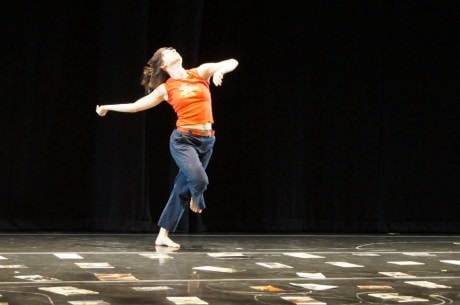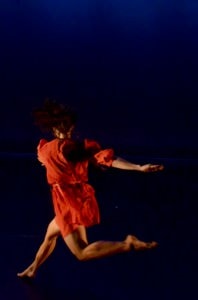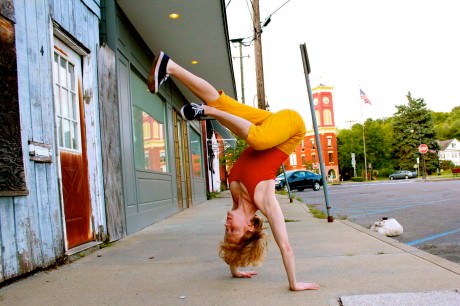The Clarice Smith Performing Arts Center hosted the 31st Annual Choreographers’ Showcase this past weekend. The program welcomed seven modern dance works, which were all adjudicated by Sidra Bell and Zvi Gotheiner; both internationally acclaimed artists with ties to the New York dance scene. As the showcase unfolded, I saw a number of commonalities in the various works, such as inaudible text, pedestrian clothing, and minimalist sound scores. These commonalities didn’t deter me, but rather strike me as interesting “fads” in the work of this time, and I wonder what dance historians will say about this time years from now.

The first piece in the showcase, Fork choreographed by Stephanie Miracle and performed by Miracle and Kate Folsom, in vibrantly colored almost vintage separates. This piece is a companion piece to Miracle’s thesis work Pleated, which will premiere in March 2014 at the Clarice Smith Performing Arts Center. The piece began with Folsom and Miracle engaged in a physical struggle. A theme that developed as the piece carried on is the idea of dead weight versus active partnering. The dancers spent a lot of time tangled in on each other, especially in various handholds, representing the entanglements of relationships. It’s easy to get wrapped up in a relationship with another person, platonic or otherwise, but how to untangle and retain your separateness is oftentimes the tricky part. Folsom and Miracle exhibited simultaneously fearless and organic performances. The piece felt playful and emotionally charged, which was intentional, Miracle shared with the audience in the talkback. The piece was set to a remix of the intro of Simon & Garfunkel’s “Cecelia,” which is a rhythmic drum piece. As the music looped, I became less aware of the familiarity of the score and stopped expecting the song to unfold, as I know it, and took notice of how Folsom and Miracle internalized the punctuation of the rhythms in their bodies as the piece unfolded. There was also somewhat audible text involved in the piece, which Folsom shared was a “Stephanie Miracle curveball,” during the talkback. Miracle is known for adding a stipulation to her works, before show time. The text was originally a means of telling each other what was coming next in the work. Miracle’s work was enjoyable and fun with a river of meaning flowing through it, and I cannot wait to attend her thesis performance.
Human Friend, choreographed and performed by Charli Brissey, was a fascinating study in efficient and somewhat familiar gestures juxtaposed with fluid larger movement and floor work. Brissey’s work is a journey around the various corners and spaces on the stage, traveling in and out of the light, wearing brown pants and a black top that almost camouflage her in the mood lighting. The idea of idiosyncrasies having different meanings in different settings, public versus private, felt very prevalent in this work. Brissey’s eye for nuance as a choreographer, and proficiency in performing said nuance, really carried the work. Seeing the same gesture with a nuanced forcus gave the familiar gestures an unfamiliar meaning in the repetition. Brissey’s piece included a little text and she shared in the talkback, “Words come out.” Since we talk as humans, it’s only natural that there be text, if it feels appropriate in the work.

Her Flowers, choreographed and performed by Francesca Jandasek and Stephanie Yezek Jolivet, is an intriguing mash-up of baroque dance and modern dance, with overtly sexual themes explored in rather beautiful ways. The colors white and red were very prevalent in the costuming, with one dancer in a white skirt and another dancer in a white leotard. Both wore vibrant red wigs and stark white, intricate masks. One dancer had a single red flower at the center of her skirt, the other with red flowers on her breasts. The piece unfolded in three sections, all centered on sexual exploration and awakening. The first section, set to a beautiful harp score, looked at singular sexual exploration, with beautiful spinal articulations that mirrored the plucks of the harp strings. The second section, set to a baroque score with a man reading Madonna’s “Like a Virgin” lyrics, unfolded like foreplay. There was a great awareness of each other, but the movement was rather coy. Every so often one of the dancers would touch her flower(s), and look at the other dancer, rather coquettishly. The third section felt like the climax of an affair, with the rush of emotions both positive and negative explored through larger movements. The skirt-clad dancer eventually showered the leotard-clad dancer with red rose petals from inside her skirt, perhaps signifying an awakening to a new level of sexual consciousness. In the talkback, Jandasek spoke about how she sees live performance as a form of communication and an honor, and that honor was carried through in the meticulous details in both choreography and costuming.
The second act opened with If Only I Knew, choreographed by Bethany Disque and performed by Disque and Chelsea Brown, who served as assistant choreographer. The piece began with the two dancers in very close proximity to a bright floodlight, standing in subtle pedestrian attire. The light exposed a diagonal from downstage left to upstage right, and this diagonal would prove as a strong spatial anchor for the work. The first half of the piece explored the evolution of the relationship between the two dancers, and simultaneously showcased the ebb and flow of their collective relationship to the light. At times, the light was all they wanted so their proximity to it was close, while at other times it was far from what they needed, so there was great distance between them and the light. Set to a sparse piano score, “Fjogur Pianó” by Sigur Rós, this piece was akin to watching a silent indie film, even though the piece incorporated inaudible text. The second section of the work involved gorgeous repetitive. The movement began supple and lush, with the dancers giving into the floor and moving with efficient pathways through space, and became dynamic and fast, with nice uses of speed and intensity. During the talkback, Brown spoke about how the text came from talking to each other in rehearsal. She also added that they like to add a change before each performance, to keep things fresh. The piece flowed very naturally, almost cyclically, and made for a pleasant exploration of the evolution of a partnership, and how said partnership endures external pressures and obstacles.
3, choreographed by Nicole A. Martinell and performed by Melissa Brady, Kelly Hall, and Olivia Serrill, began with the trio of dancers in an almost huddle. The huddle of women, clad in caramel shift dresses, moved as one unit, a well-oiled machine. This section of the work involved a lot of give and take, and the synchronicity of the three dancers was absolutely breathtaking to behold. As the trio began to explore movement as individuals, as opposed to a connected entity, a scampering motif evolved, and reminded me of visuals of atoms moving and coexisting in space.
Martinell’s choreography seemed to establish a bodyline as a theme, and then break said line once it was an established visual landmark. The way the dancers intertwined, and crossed paths, as the piece progressed was much like atoms expanding and contracting. During the talkback, one of the dancers mentioned that since the audition, the piece settled in, with more music clarity and syncing the music and movement phrasing. That was beautifully evident in watching the piece.
The Construction, choreographed and performed by Robin Neveu Brown and Connor Voss, was a rather interesting experience to watch, as it was “a performance about making a performance.” As the dancers discreetly crept onstage in front of the curtain, the backstage crew transformed the space, by opening the curtains, tying up wing curtains, etc. Once the stage was set, the dancers travelled across the front of the stage in rhythmic pattern of movement. Once the dancers arrived at their destination, they began repetitive weight shifts and stripped down layers of clothing, while talking about a woman from the audience after the matinee performance that had notes for them. Cue the sudden black out. Voss and Brown, scantily clad with flashlights on their stomach, performed a simultaneously supple and sharp phrase of movement with their shadows on the cyc and the lights on their stomachs creating a mesmerizing visual.

As a student and former student of the University of Maryland, and familiar with the performance space, they worked to transform the space into something unfamiliar, which was not only a great success in their work but broke up the monotony of a proscenium dance performance. Voss mentioned in the talkback that he likes “that audiences can leave with more questions than they came in with,” and that is something I took away from this work. It is not everyone’s cup of tea, but I found myself intrigued by a number of the movement motifs, the use of text, and the sections of the work. I felt that the visual experience of this work was rather pleasing, and the mental experience of watching this work was a little challenging, and the way that these experiences manifested themselves in my mind was unique and inspired.
The showcase ended with the most dynamic and thrilling piece of the evening by far, Benchmarks, choreographed by Adrienne Clancy and performed by Jessica Ellis, Jason Fowler, Mao Hamada, Natalia Pinzon, Jade Treadwell *(adjustments were made to the cast, but there was no paperwork for the audience to know which dancers were added/subtracted, so some of these dancers may not have performed). The dancers’ calm intensity in performing Clancy’s acrobatic and daring choreography was absolutely breathtaking to behold. The agility with which the dancers of disparate heights performed the same floor work in unison was also a testament to both the strength of the choreography and performances. The partner work was nothing if not efficient, in the way two dancers manipulated a bench with a dancer perched precariously on it and the way they manipulated each other. The unison section toward the end of the piece, with one dancer per bench, was effective, precise, and thrilling. Clancy spoke eloquently in the talkback about how she likes a sense of suspense and thrill in live performance, which is communicated effortlessly in this work. She said that she sees herself as Disney when it comes to her choreography, and that she likes to have something for everyone in the choreography. Younger audience members and those looking to be entertained can take in the splendor of the tricks with the benches, and other audience members can read into the meaning of various moments with the dancers and the benches. This piece was by far the standout of the evening; in it’s meticulous precision, the dancers’ execution, and reception by the audience.
The 31st Annual Choreographers’ Showcase was an evening of inspired dance works by a number of truly engaging artists. This year’s showcase was on the moodier side of modern dance, with a leaning toward the more psychological works. I wonder if, in the future, the overall evening of work presented could be taken into consideration, so there is a wider variety of tone and theme to the evening. A few more dynamic pieces would have made for a more balanced program.
The Clarice Smith Performing Arts Center is located at Stadium Drive & University Boulevard, in College Park, MD. Check out their website for their upcoming performances.





Thanks for the thoughtful review!!!
Adrienne Clancy